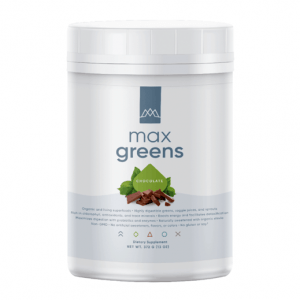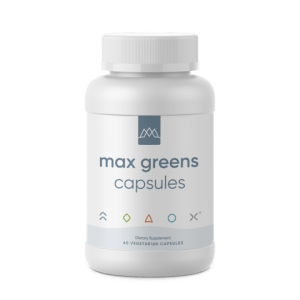Only 1 in 10 American adults meet fruit and vegetable recommendations. More specifically, only 9.3% of adults eat enough vegetables daily.
7 of the top 10 leading causes of death in the United States are from chronic diseases including heart disease, obesity, and diabetes. Eating plenty of green vegetables every day can help reduce your risk of those and other diseases. [1]
Consider heart disease. An analysis of almost half a million people found that for every additional serving of fruit and vegetables per day, the risk of heart disease was reduced by an average of 4%. [2]
Another study by Harvard –and the largest and longest study to date – looked at almost 110,000 men and women over 14 years. The higher a person’s average daily intake of fruits and vegetables, the lower their chances of developing heart disease.
Cruciferous vegetables like Brussels sprouts, kale, broccoli, and cabbage are also powerful cancer fighters. They provide glucosinolates or plant compounds that can protect against specific cancers, including lung and esophageal cancer. [3]
Eating plenty of vegetables can also balance your blood sugar and stabilize hunger, support weight loss and possibly reduce your risk of type 2 diabetes.
The Many Benefits of Vegetables
Greens provide hundreds of plant compounds that keep you healthy, protecting you against these and other diseases.
Eating a variety of green leafy and cruciferous vegetables provides those nutrients you need to thrive. [4] Among their vast array of vitamins, minerals, and other nutrients include:
- Vitamin C. Fighting a cold? Double or triple up on green vegetables like kale, which packs a whopping 134 percent of your Daily Value (DV) for vitamin C per raw cup. This water-soluble vitamin is a powerful antioxidant. [5]
- Magnesium. Leafy greens like kale, spinach, and collard greens provide significant amounts of this mineral. [6] Magnesium helps you stay calm, improves sleep, balances blood sugar, and so much more. [7]
- Fiber. Greens are good sources of dietary fiber, which keeps you full faster, helps steady your blood sugar levels, and so much more. Those are among the reasons why fiber can help you lose weight. [8] Fiber can also help prevent diabetes, heart disease, and other diseases. Experts recommend 25 grams for women and 38 grams for men. Most people only get about half that amount of fiber: 15 – 17 grams a day. A good rule of thumb: The darker the color, the more fiber you get in that green vegetable. [9]
Greens and the Power of Prevention
These and other nutrients in vegetables can keep you lean and healthy. Several problems contribute to diseases such as heart disease, diabetes, and obesity. Two big ones are oxidative stress and chronic inflammation.
Free radicals are molecules that can age you and increase your risk of disease. When those free radicals overpower your body’s antioxidant defenses, a condition called oxidative stress can result. [10]
The same thing happens with inflammation. A little bit can benefit your body when you, say, cut your finger. But inflammation should do its job and then taper down.
When inflammation persists, it becomes chronic. Chronic inflammation can play a role in most diseases including cancer, heart disease, diabetes, depression, and Alzheimer’s. [11]
Leafy and cruciferous green vegetables can help with both conditions. They contain antioxidants including lutein and beta-carotene to help your body fight free radicals. These vegetables also contain anti-inflammatory nutrients including sulforaphane. [12]
Why Don’t We Eat More Greens?
Knowing all these health benefits, why don’t more people eat green vegetables? Research shows that cost, limited availability and access, and not enough time to prepare or cook them are among the reasons why many of us don’t meet our greens quota. [13]
It’s not just kids who don’t like eating vegetables. Most adults struggle to get their daily greens requirements. But eating more vegetables shouldn’t be a struggle! These 12 strategies can help make getting more vegetables convenient, simple, and delicious.
- Make them more interesting. No more blah vegetables! Adding a little bit of cream, butter, or cheese will convert even the most veggie-phobic family member. Our Vegetables au Gratin makes the perfect starter recipe to make all your vegetables delicious, and even decadent.
- Prep ahead of time. Manufacturers know meal preparation can be time-consuming. That’s why they offer pre-washed greens, pre-cut broccoli, and prepared vegetables. What you save in time, you pay for with money. Prepping your own veggies doesn’t take much time, and you’ll definitely save money. Cut up broccoli and other cruciferous vegetables. Slice tomatoes. Tear lettuce. Store these things in airtight containers and keep in your fridge. You might cut, slice, and dice on a Sunday night for the following three days.
- Get everyone involved. Preparing and cooking vegetables alone is no fun. Pull your entire family in. Even your littlest ones can tear lettuce, and older kids can chop kale or wash and cut broccoli. Consider our Blasted Cauliflower, which gives a unique spin to this nutritious cruciferous vegetable. Your younger ones can wash and clean the cauliflower. Older kids can cut off and discard stems and chop the cauliflower florets into small pieces. Make the process fun! Put on some lively music and let someone be the DJ! Make the conversation friendly and fun.
- Hide them in yummy dishes. Sauteed zucchini tastes delicious, but it might not sound so fabulous to some ears. Hide those green vegetables in comfort-food dishes such as our Roasted Vegetable Lasagna, a surefire solution to stealthily slip in more veggies.
- Make an omelet. An omelet makes a simple way to slip more vegetables into breakfast or any meal. Use organic, pasture-raised eggs and be creative. Toss in some of the green vegetables you’ve sliced and diced. Our Spinach Omelet is the perfect veggie-packed dish. Add our Tahini Kale Salad as a side and you’ve got a quick, healthy meal rich in green vegetables for breakfast or dinner for breakfast.
- Make them portable. Wraps and sandwiches are the perfect grab-and-go lunch, but most contain gluten, added sugars, and other problem ingredients. Swap out sliced bread, buns, and whole wheat wraps for Romaine lettuce or cabbage wraps. Our Asian Turkey Lettuce Wraps make an easy, yummy take on traditional Chinese food takeout.
- Slip ‘em into smoothies. Spinach for breakfast might elicit groans. You can easily add some raw spinach or other leafy greens into your smoothie and disguise the taste with yummy ingredients like cacao nibs and almond butter. Your kids and significant other will never know until you tell them!
- Upgrade starches. Almost any time you want or need starchy carbs in your meals, you can substitute a veggie. Cauliflower rice makes a more nutrient-rich alternative to white or brown rice. Instead of spaghetti noodles, try zucchini or spaghetti squash as your pasta base. Craving fries without the starch? Our Zucchini Fries hit the spot!
- Double up in restaurants. Maybe your entree comes with broccoli and a baked potato. Simple: Ask your server to skip the potatoes and add another green vegetable, which provides more nutrients and fewer calories!
- Make it a mission to try a new one. Restaurants usually find ways to make green vegetables taste amazing. Be adventurous and try something new at your favorite bistros, such as crispy kale or sauteed Brussels sprouts with garlic.
- Buy them fresh or frozen. Frozen vegetables today are far tastier than the ones you might have grown up with. New research says they might also be healthier than fresh ones. That’s because they are often picked at peak ripeness when they’re the most nutritious. [14]
- If you can’t find or afford organic, use this list. Organic produce is often higher in nutrients. [15] But organic greens aren’t always available or practical. Some vegetables are higher in pesticides, meaning you’ll want to avoid them. The Environmental Working Group (EWG) makes choosing easy. They’ve compiled a Shopper’s Guide to Avoiding Pesticides in Produce.
Variety is key with green vegetables. To get all the nutrients they provide, you’ll want to eat a wide variety of green vegetables. Swiss chard, for instance, contains a unique flavonoid compound called syringic acid that can help lower blood sugar levels. [16]
That’s not always possible. Even when you’re at your best, getting enough green vegetables in your diet can feel challenging.
Maybe you travel frequently for work or you have an upcoming vacation lined up. Finding the healthiest vegetables at an airport or roadside diner can be difficult. But you know how important fitting those vegetables into your diet can be to feel healthy, stay lean, and prevent your risk of disease.
 That’s where Max Greens can fill your vegetable quota. This organic green powder (also available in capsules) combines green superfoods like organic wheatgrass, organic chlorella, and immune-boosting organic mushrooms.
That’s where Max Greens can fill your vegetable quota. This organic green powder (also available in capsules) combines green superfoods like organic wheatgrass, organic chlorella, and immune-boosting organic mushrooms.
Imagine packing the nutrient punch of numerous organic green vegetables — including spinach, broccoli, kale, and Brussels sprouts — into one easy-to-use powder or capsule! That’s the power of Max Greens.
Max Greens Capsules gives you 1 serving of fruit and 2 servings of vegetables in just 2 capsules.
Max Greens powder blends into smoothies or your favorite unsweetened beverage and tastes delicious. This green superfood powder is flavored with organic cocoa, making it a delicious way to boost your daily intake of antioxidants, trace minerals, and key phytonutrients.
 Green vegetables provide your best way to get the nutrients that keep you lean and prevent disease. Even when you’re using Max Greens, you’ll want to focus on the above 12 strategies to increase your greens intake.
Green vegetables provide your best way to get the nutrients that keep you lean and prevent disease. Even when you’re using Max Greens, you’ll want to focus on the above 12 strategies to increase your greens intake.
Think of Max Greens as a delicious, simple-to-use go-to powder when you struggle to fit in those healthy vegetables your body needs to stay lean and healthy.
References
- https://www.cdc.gov/media/releases/2017/p1116-fruit-vegetable-consumption.html
- https://www.hsph.harvard.edu/nutritionsource/what-should-you-eat/vegetables-and-fruits/
- https://www.healthline.com/nutrition/leafy-green-vegetables
- https://www.hsph.harvard.edu/nutritionsource/what-should-you-eat/vegetables-and-fruits/
- https://www.intechopen.com/books/vitamin-c/vitamin-c-an-antioxidant-agent
- https://www.healthline.com/nutrition/10-foods-high-in-magnesium#section10
- https://www.healthline.com/nutrition/magnesium-and-sleep
- https://www.ncbi.nlm.nih.gov/pubmed/31174214
- https://www.ucsfhealth.org/education/increasing_fiber_intake/
- https://www.healthline.com/nutrition/leafy-green-vegetables
- https://www.health.harvard.edu/staying-healthy/foods-that-fight-inflammation
- https://www.healthline.com/nutrition/13-anti-inflammatory-foods#section3
- https://www.cdc.gov/nccdphp/dnpao/division-information/media-tools/adults-fruits-vegetables.html
- https://www.healthline.com/nutrition/fresh-vs-frozen-fruit-and-vegetables#section1
- https://www.ncbi.nlm.nih.gov/pubmed/20359265
- https://www.healthline.com/nutrition/leafy-green-vegetables


